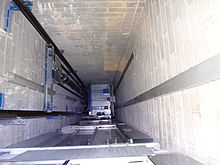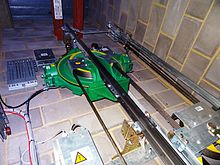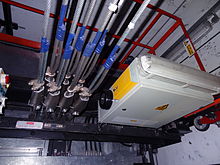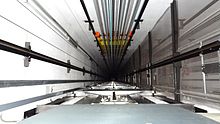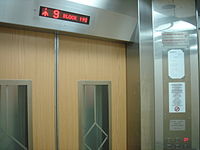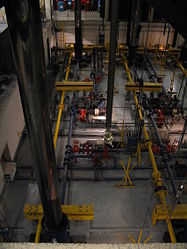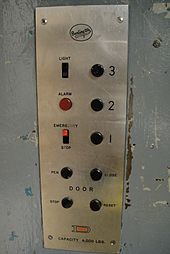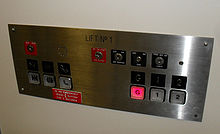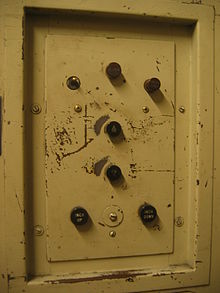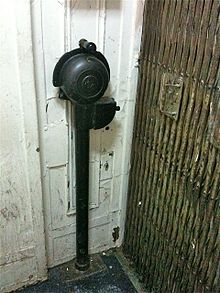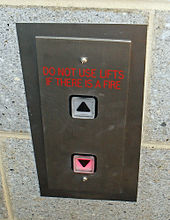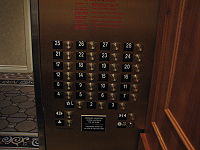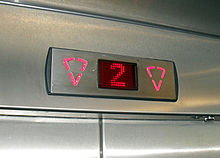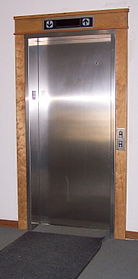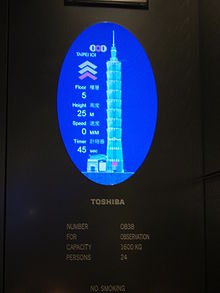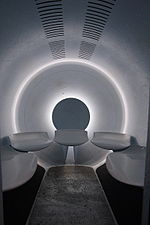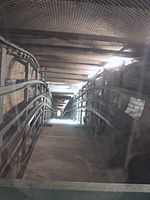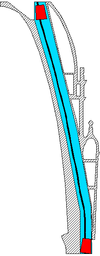- Elevator
-
For other uses, see Elevator (disambiguation).
 A set of lifts in the lower level of a London Underground station. The arrows indicate each elevator's position and direction of travel.
A set of lifts in the lower level of a London Underground station. The arrows indicate each elevator's position and direction of travel. This elevator to the Alexanderplatz U-Bahn station in Berlin is built with glass walls, exposing the inner workings.
This elevator to the Alexanderplatz U-Bahn station in Berlin is built with glass walls, exposing the inner workings.
An elevator (or lift in British English) is a type of vertical transport equipment that efficiently moves people or goods between floors (levels, decks) of a building, vessel or other structures. Elevators are generally powered by electric motors that either drive traction cables or counterweight systems like a hoist, or pump hydraulic fluid to raise a cylindrical piston like a jack.
Languages other than English may have loanwords based on either elevator (e.g., Korean & Japanese) or lift (e.g., Russian & Cantonese).
Because of wheelchair access laws, elevators are often a legal requirement in new multistory buildings, especially where wheelchair ramps would be impractical.
Design
Some people argue that lifts began as simple rope or chain hoists (see Traction elevators below). A lift is essentially a platform that is either pulled or pushed up by a mechanical means. A modern day lift consists of a cab (also called a "cage" or "car") mounted on a platform within an enclosed space called a shaft or sometimes a "hoistway". In the past, lift drive mechanisms were powered by steam and water hydraulic pistons or by hand. In a "traction" lift, cars are pulled up by means of rolling steel ropes over a deeply grooved pulley, commonly called a sheave in the industry. The weight of the car is balanced by a counterweight. Sometimes two lifts always move synchronously in opposite directions, and they are each other's counterweight.
The friction between the ropes and the pulley furnishes the traction which gives this type of lift its name.
Hydraulic lifts use the principles of hydraulics (in the sense of hydraulic power) to pressurize an above ground or in-ground piston to raise and lower the car (see Hydraulic elevators below). Roped hydraulics use a combination of both ropes and hydraulic power to raise and lower cars. Recent innovations include permanent magnet motors, machine room-less rail mounted gearless machines, and microprocessor controls.
The technology used in new installations depends on a variety of factors. Hydraulic lifts are cheaper, but installing cylinders greater than a certain length becomes impractical for very high lift hoistways. For buildings of much over seven storeys, traction lifts must be employed instead. Hydraulic lifts are usually slower than traction lifts.
Lifts are a candidate for mass customization. There are economies to be made from mass production of the components, but each building comes with its own requirements like different number of floors, dimensions of the well and usage patterns.
Elevator doors
Elevator doors protect riders from falling into the shaft. The most common configuration is to have two panels that meet in the middle, and slide open laterally. In a cascading telescopic configuration (potentially allowing wider entryways within limited space), the doors run on independent tracks so that while open, they are tucked behind one another, and while closed, they form cascading layers on one side. This can be configured so that two sets of such cascading doors operate like the center opening doors described above, allowing for a very wide elevator cab. In less expensive installations the elevator can also use one large "slab" door: a single panel door the width of the doorway that opens to the left or right laterally. Some buildings have elevators with the single door on the shaft way, and double cascading doors on the cab.
Machine room-less (MRL) Elevators
General
for a single or a group of elevators.
Machine room-less elevators are designed so that most of the components fit within the shaft containing the elevator car; and a small cabinet houses the elevator controller. Other than the machinery being in the hoistway, the equipment is similar to a normal traction elevator.
This new design was first developed by Kone in 1996.
Benefits
- creates more usable space
- use less energy (70-80% less than hydraulic elevators)
- uses no oil
- all components are above ground similar to roped hydraulic type elevators (this takes away the environmental concern that was created by the hydraulic cylinder on direct hydraulic type elevators being stored underground)
- slightly lower cost than other elevators
- can operate at faster speeds than hydraulics but not normal traction units
Detriments
- Equipment can be harder to service and maintain.
- No code has been approved for the installation of Residential elevator Equipment.
Facts
- Noise level is at 50-55 dBA (A-weighted decibels), which can be lower than some but not all types of elevators
- Usually used for low-rise to mid-rise buildings
- The motor mechanism is placed in the hoistway itself
- The US was slow to accept the commercial MRL Elevator because of codes
---national and local building codes did not address elevators without machine rooms. Residential MRL Elevators are still not allowed by the ASME A17 code in the US.
Elevator Traffic Calculations
Round trip time calculations
The majority of elevator designs are developed from Up Peak Round Trip Time calculations as described in the following publications:- CIBSE Guide D: Transportation Systems in Building[1] Elevator Traffic Handbook, Theory and Practice. Gina Barney[2] The Vertical Transportation Handbook. George Strakosch[3]
Traditionally these calculations have formed the basis of establishing the Handling Capacity of an elevator system.
Modern Installations with more complex elevator arrangements have led to the development of more specific formulae such as the General Analysis calculation.[4]
Subsequently this has been extended for Double Deck elevators.[5]
Simulation
Elevator traffic simulation software can be used to model complex traffic patterns and elevator arrangements that cannot necessarily be analysed by RTT calculations.[6]
Lift traffic patterns
There are four main types of elevator traffic patterns that can be observed in most modern office installations. They are up peak traffic, down peak traffic, lunch time (two way) traffic and interfloor traffic.
Elevator modernization
Most elevators are built to provide about 20 years of service, as long as service intervals specified and periodic maintenance/inspections by the manufacturer are followed. As the elevator ages and equipment become increasingly difficult to find or replace, along with code changes and deteriorating ride performance, a complete overhaul of the elevator may be suggested to the building owners.
A typical modernization consists of controller equipment, electrical wiring and buttons, position indicators and direction arrows, hoist machines and motors (including door operators), and sometimes door hanger tracks. Rarely are car slings, rails, or other heavy structures changed. The cost of an elevator modernization can range greatly depending on which type of equipment is to be installed.
Modernization can greatly improve operational reliability by replacing mechanical relays and contacts with solid-state electronics. Ride quality can be improved by replacing motor-generator-based drive designs with Variable-Voltage, Variable Frequency (V3F) drives, providing near-seamless acceleration and deceleration. Passenger safety is also improved by updating systems and equipment to conform to current codes.
History
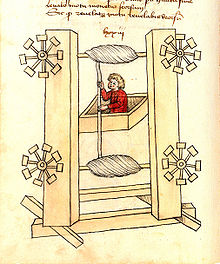 Elevator design by the German engineer Konrad Kyeser (1405)
Elevator design by the German engineer Konrad Kyeser (1405)
The first reference to an elevator is in the works of the Roman architect Vitruvius, who reported that Archimedes (c. 287 BC – c. 212 BC) built his first elevator probably in 236 BC. In some literary sources of later historical periods, elevators were mentioned as cabs on a hemp rope and powered by hand or by animals. It is supposed that elevators of this type were installed in the Sinai monastery of Egypt.
In 1000, the Book of Secrets by Ibn Khalaf al-Muradi in Islamic Spain described the use of an elevator-like lifting device, in order to raise a large battering ram to destroy a fortress.[7] In the 17th century the prototypes of elevators were located in the palace buildings of England and France.
Ancient and medieval elevators used drive systems based on hoists or winders. The invention of a system based on the screw drive was perhaps the most important step in elevator technology since ancient times, leading to the creation of modern passenger elevators. The first screw drive elevator was built by Ivan Kulibin and installed in Winter Palace in 1793. Several years later another of Kulibin's elevators was installed in Arkhangelskoye near Moscow. In 1823, an "ascending room" made its debut in London.[8]
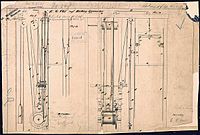 Elisha Otis' elevator patent drawing, 15 January 1861.
Elisha Otis' elevator patent drawing, 15 January 1861.
In the middle 1800s, there were many types of crude elevators that carried freight. Most of them ran hydraulically. The first hydraulic elevators used a plunger below the car to raise or lower the elevator. A pump applied water pressure to a steel column inside a vertical cylinder. Increasing the pressure caused the elevator to ascend. The elevator also used a system of counter-balancing so that the plunger did not have to lift the entire weight of the elevator and its load. The plunger, however, was not practical for tall buildings, because it required a pit as deep below the building as the building was tall. Later, a rope-geared elevator with multiple pulleys was developed.
Henry Waterman of New York is credited with inventing the "standing rope control" for an elevator in 1850.[9]
In 1852, Elisha Otis introduced the safety elevator, which prevented the fall of the cab if the cable broke. The design of the Otis safety elevator is somewhat similar to one type still used today. A governor device engages knurled roller(s), locking the elevator to its guides should the elevator descend at excessive speed. He demonstrated it at the New York exposition in the Crystal Palace in a dramatic, death-defying presentation in 1854.[9][10]
On March 23, 1857 the first Otis passenger elevator was installed at 488 Broadway in New York City.
The first elevator shaft preceded the first elevator by four years. Construction for Peter Cooper's Cooper Union Foundation building in New York began in 1853. An elevator shaft was included in the design, because Cooper was confident that a safe passenger elevator would soon be invented.[11] The shaft was cylindrical because Cooper felt it was the most efficient design.[12] Later, Otis designed a special elevator for the building. Today the Otis Elevator Company, now a subsidiary of United Technologies Corporation, is the world's largest manufacturer of vertical transport systems.
The first electric elevator was built by Werner von Siemens in 1880.[13] The safety and speed of electric elevators were significantly enhanced by Frank Sprague.[citation needed] The inventor Anton Freissler developed the ideas of von Siemens and built up a successful enterprise in Austria-Hungary.
The development of elevators was led by the need for movement of raw materials including coal and lumber from hillsides. The technology developed by these industries and the introduction of steel beam construction worked together to provide the passenger and freight elevators in use today.
In 1874, J.W. Meaker patented a method which permitted elevator doors to open and close safely. U.S. Patent 147,853
In 1882, when hydraulic power was a well established technology, a company later named the London Hydraulic Power Company was formed. It constructed a network of high pressure mains on both sides of the Thames which, ultimately, extended to 184 miles and powered some 8,000 machines, predominantly lifts (elevators) and cranes.[14]
In 1887, American Inventor Alexander Miles of Duluth, Minnesota patented an elevator with automatic doors that would close off the elevator shaft.
Elevator safety
Cable-borne elevators
Statistically speaking, cable-borne elevators are extremely safe. Their safety record is unsurpassed by any other vehicle system. In 1998, it was estimated that approximately eight millionths of one percent (1 in 12 million) of elevator rides result in an anomaly, and the vast majority of these were minor things such as the doors failing to open. For all practical purposes, there are no cases of elevators simply free-falling and killing the passengers inside; of the 20 to 30 elevator-related deaths each year, most of them are maintenance-related - for example, technicians leaning too far into the shaft or getting caught between moving parts,[15] and most of the rest are attributed to easily avoidable accidents, such as people stepping blindly through doors that open into empty shafts or being strangled by scarves caught in the doors.[15] In fact, prior to the September 11th terrorist attacks, the only known free-fall incident in a modern cable-borne elevator happened in 1945 when a B-25 bomber struck the Empire State Building in fog, severing the cables of an elevator cab, which fell from the 75th floor all the way to the bottom of the building, seriously injuring (though not killing) the sole occupant - the female elevator operator.[16] However, there was an incident in 2007 at a Seattle children's hospital, where a ThyssenKrupp ISIS machine room-less elevator free-fell until the safety brakes were engaged. This was due to a flaw in the design where the cables were connected at one common point, and the kevlar ropes had a tendency to overheat and cause slipping (or, in this case, a free-fall). While it is possible (though extraordinarily unlikely) for an elevator's cable to snap, all elevators in the modern era have been fitted with several safety devices which prevent the elevator from simply free-falling and crashing. An elevator cab is typically borne by six or eight hoist cables, each of which is capable on its own of supporting the full load of the elevator plus twenty-five percent more weight. In addition, there is a device which detects whether the elevator is descending faster than its maximum designed speed; if this happens, the device causes copper brake shoes to clamp down along the vertical rails in the shaft, stopping the elevator quickly, but not so abruptly as to cause injury. This device is called the governor, and was invented by Elisha Graves Otis.[16] In addition, a hydraulic buffer is installed at the bottom of the shaft to somewhat cushion any impact.[15]
Hydraulic elevators
Past problems with early hydraulic elevators meant those built prior to a code change in 1972 were subject to possible catastrophic failure. The code had previously required only single-bottom hydraulic cylinders. In the event of a cylinder breach, an uncontrolled fall of the elevator might result. Because it is impossible to verify the system completely without a pressurized casing (as described below), it is necessary to remove the piston to inspect it. The cost of removing the piston is such that it makes no economic sense to re-install the old cylinder; therefore it is necessary to replace the cylinder and install a new piston.[citation needed] Another solution to protect against a cylinder blowout is to install a "life jacket." This is a device which, in the event of an excessive downward speed, clamps onto the cylinder and stops the car. A device known as a rupture valve is often attached to the hydraulic inlet/outlet of the piston and can be adjusted for a maximum flow rate. If a pipe or hose were to break (rupture), the flow rate of the rupture valve will surpass a set limit and mechanically stop the outlet flow of hydraulic fluid, thus stopping the piston and the car in the down direction.
In addition to the safety concerns for older hydraulic elevators, there is risk of leaking hydraulic oil into the aquifer and causing potential environmental contamination. This has led to the introduction of PVC liners (casings) around hydraulic cylinders which can be monitored for integrity.
In the past decade, recent innovations in inverted hydraulic jacks have eliminated the costly process of drilling the ground to install a borehole jack. This also eliminates the threat of corrosion to the system and increases safety.
Mine-shaft elevators
Safety testing of mine shaft elevator rails is routinely undertaken. The method involves destructive testing of a segment of the cable. The ends of the segment are frayed, then set in conical zinc molds. Each end of the segment is then secured in a large, hydraulic stretching machine. The segment is then placed under increasing load to the point of failure. Data about elasticity, load, and other factors is compiled and a report is produced. The report is then analyzed to determine whether or not the entire rail is safe to use.
Uses of elevators
A residential elevator in Singapore.
Passenger service
A passenger elevator is designed to move people between a building's floors.
Passenger elevators capacity is related to the available floor space. Generally passenger elevators are available in capacities from 1,000 to 6,000 pounds (450–2,700 kg) in 500 lb (230 kg) increments.[citation needed] Generally passenger elevators in buildings eight floors or less are hydraulic or electric, which can reach speeds up to 200 ft/min (1.0 m/s) hydraulic and up to 500 ft/min electric. In buildings up to ten floors, electric and gearless elevators are likely to have speeds up to 500 ft/min (2.5 m/s), and above ten floors speeds begin at 500 ft/min (2.5 m/s) up to 2000 ft/min (10 m/s).[citation needed]
Sometimes passenger elevators are used as a city transport along with funiculars. For example, there is a 3-station underground public elevator in Yalta, Ukraine, which takes passengers from the top of a hill above the Black Sea on which hotels are perched, to a tunnel located on the beach below. At Casco Viejo station in the Bilbao Metro, the elevator that provides access to the station from a hilltop neighborhood doubles as city transportation: the station's ticket barriers are set up in such a way that passengers can pay to reach the elevator from the entrance in the lower city, or vice versa. See also the Elevators for urban transport section.
The Equitable Building completed in 1870 in New York City was the first office building to have passenger elevators.[17]
Types of passenger elevators
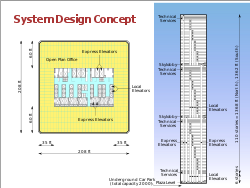 The former World Trade Center's twin towers used skylobbies, located on the 44th and 78th floors of each tower.
The former World Trade Center's twin towers used skylobbies, located on the 44th and 78th floors of each tower.
Passenger elevators may be specialized for the service they perform, including: hospital emergency (Code blue), front and rear entrances, a television in high rise buildings, double decker, and other uses. Cars may be ornate in their interior appearance, may have audio visual advertising, and may be provided with specialized recorded voice instructions.
An express elevator does not serve all floors. For example, it moves between the ground floor and a skylobby, or it moves from the ground floor or a skylobby to a range of floors, skipping floors in between. These are especially popular in eastern Asia.
Capacity
Residential elevators may be small enough to only accommodate one person while some are large enough for more than a dozen. Wheelchair, or platform lifts, a specialized type of elevator designed to move a wheelchair 6 ft (1.8 m) or less, can often accommodate just one person in a wheelchair at a time with a load of 1000 lb (450 kg).[citation needed]
Freight elevators
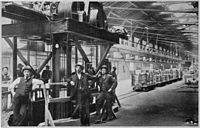 A specialized elevator from 1905 for lifting narrow gauge railroad cars between a railroad freight house and the Chicago Tunnel Company tracks below.
A specialized elevator from 1905 for lifting narrow gauge railroad cars between a railroad freight house and the Chicago Tunnel Company tracks below.
A freight elevator, or goods lift, is an elevator designed to carry goods, rather than passengers. Freight elevators are generally required to display a written notice in the car that the use by passengers is prohibited (though not necessarily illegal), though certain freight elevators allow dual use through the use of an inconspicuous riser. Freight elevators are typically larger and capable of carrying heavier loads than a passenger elevator, generally from 2,300 to 4,500 kg. Freight elevators may have manually operated doors, and often have rugged interior finishes to prevent damage while loading and unloading. Although hydraulic freight elevators exist, electric elevators are more energy efficient for the work of freight lifting.[citation needed]
Stage lifts
Stage and orchestra lifts are specialized lifts, typically powered by hydraulics, that are used to lift entire sections of a theater stage. For example, Radio City Music Hall has four such lifts: an "orchestra lift" that covers a large area of the stage, and three smaller lifts near the rear of the stage. In this case, the orchestra lift is powerful enough to raise an entire orchestra, or an entire cast of performers (including live elephants) up to stage level from below.
Vehicle elevators
Vehicular elevators are used within buildings or areas with limited space (in lieu of ramps), typically to move cars into the parking garage or manufacturer's storage. Geared hydraulic chains (not unlike bicycle chains) generate lift for the platform and there are no counterweights. To accommodate building designs and improve accessibility, the platform may rotate so that the driver only has to drive forward. Most vehicle elevators have a weight capacity of 2 tons.
Rare examples of extra-heavy elevators for 20-ton lorries, and even for railcars (like one that was used at Dnipro Station of the Kiev Metro) also occur.
Boat elevators
Main article: Boat liftIn some smaller canals, boats and small ships can pass between different levels of a canal with a boat lift rather than through a canal lock.
Aircraft elevators
 An F/A-18C on an aircraft elevator of the USS Kitty Hawk
An F/A-18C on an aircraft elevator of the USS Kitty Hawk
On aircraft carriers, elevators carry aircraft between the flight deck and the hangar deck for operations or repairs. These elevators are designed for much greater capacity than other elevators, up to 200,000 pounds (90 tonnes) of aircraft and equipment. Smaller elevators lift munitions to the flight deck from magazines deep inside the ship.
On some passenger double-deck aircraft such as the Boeing 747, Lockheed L-1011 or other widebody aircraft, lifts transport flight attendants and food and beverage trolleys from lower deck galleys to upper passenger carrying decks.
Residential elevator
The residential elevator is often permitted to be of lower cost and complexity than full commercial elevators. They may have unique design characteristics suited for home furnishings, such as hinged wooden shaft-access doors rather than the typical metal sliding doors of commercial elevators. Construction may be less robust than in commercial designs with shorter maintenance periods, but safety systems such as locks on shaft access doors, fall arrestors, and emergency phones must still be present in the event of malfunction.
Limited Use / Limited Application
The limited-use, limited-application (LU/LA) elevator is a special purpose passenger elevator used infrequently, and which is exempt from many commercial regulations and accommodations. For example, a LU/LA is primarily meant to be handicapped accessible, and there might only be room for a single wheelchair and a standing passenger.
Dumbwaiter
Main article: Dumbwaiter (elevator)Dumbwaiters are small freight elevators that are intended to carry food rather than passengers. They often link kitchens with rooms on other floors.
Paternoster
Main article: PaternosterA special type of elevator is the paternoster, a constantly moving chain of boxes. A similar concept, called the manlift or humanlift, moves only a small platform, which the rider mounts while using a handhold and was once seen in multi-story industrial plants.
Scissor lift
The scissor lift is yet another type of lift. As most of these lifts are self-contained, these lifts can be easily moved to where they are needed.
Rack-and-pinion lift
The rack-and-pinion lift is another type of lift. This lifts are simpler in construction, but noisy and slow. They are nonetheless the most used type of lift for buildings under construction (to move materials and tools up and down).
Material handling belts and belt elevators
A different kind of elevator is used to transport material. It generally consists of an inclined plane on which a conveyor belt runs. The conveyor often includes partitions to prevent the material from sliding backwards. These elevators are often used in industrial and agricultural applications. When such mechanisms (or spiral screws or pneumatic transport) are used to elevate grain for storage in large vertical silos, the entire structure is called a grain elevator.
There have occasionally been lift belts for humans; these typically have steps about every seven feet along the length of the belt, which moves vertically, so that the passenger can stand on one step and hold on to the one above. These belts are sometimes used, for example, to carry the employees of parking garages, but are considered too dangerous for public use.
Types of hoist mechanisms
There are at least four means of moving an elevator:
Traction elevators
- Geared and gearless traction elevators
Geared traction machines are driven by AC or DC electric motors. Geared machines use worm gears to control mechanical movement of elevator cars by "rolling" steel hoist ropes over a drive sheave which is attached to a gearbox driven by a high speed motor. These machines are generally the best option for basement or overhead traction use for speeds up to 500 ft/min (2.5 m/s). In order to allow accurate speed control of the motor, to allow accurate levelling and for passenger comfort, a DC hoist motor powered by an AC/DC motor-generator (MG) set was the preferred solution in high-traffic elevator installations for many decades. The MG set also typically powered the relay controller of the elevator, which has the added advantage of electrically isolating the elevators from the rest of a building's electrical system - eliminating the transient power spikes in the building's electrical supply caused by the motors starting and stopping (causing lighting to dim every time the elevators are used for example), as well as interference to other electrical equipment caused by the arcing of the relay contactors in the control system.
Contemporary cheaper installations, such as those in residential buildings and low-traffic commercial applications generally used a single or two speed AC hoist machine. The widespread availability of cheap solid state AC drives has allowed infinitely variable speed AC motors to be used universally, bringing with it the advantages of the older motor-generator based systems, without the penalties in terms of efficiency and complexity. The older MG-based installations are gradually being replaced in older buildings due to their poor energy efficiency.
Gearless traction machines are low speed (low RPM), high torque electric motors powered either by AC or DC. In this case, the drive sheave is directly attached to the end of the motor. Gearless traction elevators can reach speeds of up to 2,000 ft/min (10 m/s), or even higher. A brake is mounted between the motor and drive sheave (or gearbox) to hold the elevator stationary at a floor. This brake is usually an external drum type and is actuated by spring force and held open electrically; a power failure will cause the brake to engage and prevent the elevator from falling (see inherent safety and safety engineering).
In each case, cables are attached to a hitch plate on top of the cab or may be "underslung" below a cab, and then looped over the drive sheave to a counterweight attached to the opposite end of the cables which reduces the amount of power needed to move the cab. The counterweight is located in the hoist-way and rides a separate railway system; as the car goes up, the counterweight goes down, and vice versa. This action is powered by the traction machine which is directed by the controller, typically a relay logic or computerized device that directs starting, acceleration, deceleration and stopping of the elevator cab. The weight of the counterweight is typically equal to the weight of the elevator cab plus 40-50% of the capacity of the elevator. The grooves in the drive sheave are specially designed to prevent the cables from slipping. "Traction" is provided to the ropes by the grip of the grooves in the sheave, thereby the name. As the ropes age and the traction grooves wear, some traction is lost and the ropes must be replaced and the sheave repaired or replaced. Sheave and rope wear may be significantly reduced by ensuring that all ropes have equal tension, thus sharing the load evenly. Rope tension equalisation may be achieved using a rope tension gauge, and is a simple way to extend the lifetime of the sheaves and ropes.
Elevators with more than 100' (30 m) of travel have a system called compensation. This is a separate set of cables or a chain attached to the bottom of the counterweight and the bottom of the elevator cab. This makes it easier to control the elevator, as it compensates for the differing weight of cable between the hoist and the cab. If the elevator cab is at the top of the hoist-way, there is a short length of hoist cable above the car and a long length of compensating cable below the car and vice versa for the counterweight. If the compensation system uses cables, there will be an additional sheave in the pit below the elevator, to guide the cables. If the compensation system uses chains, the chain is guided by a bar mounted between the counterweight railway lines.
Hydraulic elevators
- Conventional hydraulic elevators. They use an underground cylinder, are quite common for low level buildings with 2-5 floors (sometimes but seldom up to 6-8 floors), and have speeds of up to 200 feet/minute (1 meter/second).
- Holeless hydraulic elevators were developed in the 1970s, and use a pair of above ground cylinders, which makes it practical for environmentally or cost sensitive buildings with 2, 3, or 4 floors.
- Roped hydraulic elevators use both above ground cylinders and a rope system, which combines the reliability of inground hydraulic with the versatility of holeless hydraulic, even though they can serve up to 8-10 floors.
The low mechanical complexity of hydraulic elevators in comparison to traction elevators makes them ideal for low rise, low traffic installations. The main disadvantage is their lower efficiency – with no counterbalancing, they require more power to operate – and most of the potential energy of the car once it is raised is lost since gravity is used to lower the car. The high current draw of the pump when starting up also places higher demands on a building’s electrical system. There are also environmental concerns should either the lifting cylinder leak fluid into the ground.
The modern generation of low cost, machine room-less traction elevators made possible by advances in motor and motor drive technology is beginning to challenge the supremacy of the hydraulic elevator in their traditional market niche.
Climbing elevator
A climbing elevator is a self-ascending elevator with its own propulsion. The propulsion can be done by an electric or a combustion engine. Climbing elevators are used in guyed masts or towers, in order to make easy access to parts of these constructions, such as flight safety lamps for maintenance. An example would be the Moonlight towers in Austin, Texas, where the elevator holds only one person and equipment for maintenance. The Glasgow Tower - an observation tower in Glasgow, Scotland also makes use of two climbing elevators.
Elevator air conditioning
Concept
Elevator air conditioning is fast becoming a popular concept around the world. The primary reason for installing an elevator air conditioner is the comfort that it provides while traveling in the elevator. It stabilizes the condition of the air inside the lift car. Some elevator air conditioners can be used in countries with cold climates if a thermostat is used to reverse the refrigeration cycle to warm the lift car.
Health
One of the benefits of installing an elevator air conditioner is the clean air it provides. Air was typically drawn from the elevator shaft or hoistway into the car using a motorized fan. This air could contain dust mites, germs and bacteria. With an elevator air conditioner, the air is much cleaner because it is recirculated within the car itself and is usually filtered to remove contaminants. A poorly maintained air-conditioning system may promote the growth and spread of microorganisms, but as long as the air conditioner is kept clean, these health hazards can be avoided.
Drawbacks
Heat generated from the cooling process is dissipated into the hoistway. The elevator cab (or car) is not air-tight, and some of this heat will reenter the car and reduce the overall cooling effect, which may be less than ideal.
Energy
The air from the lobby constantly leaks into the elevator shaft due to elevator movements as well as elevator shaft ventilation requirements. Using this conditioned air in the elevator does not increase energy costs. However, by using an independent elevator air conditioner to achieve better temperature control inside the car, more energy will be used.
Condensation
Air conditioning poses a problem to elevators because of the condensation that occurs. The condensed water produced has to be disposed of; otherwise, it would create flooding in the elevator car and hoistway.
Ways to remove condensed water
There are at least four ways to remove condensed water from the air conditioner. However, each solution has its pros and cons.
Atomizing
Atomizing, also known as misting the condensed water, is another way to dispose of the condensed water. Spraying ultra-fine water droplets onto the hot coils of the air conditioner ensures that the condensed water evaporates quickly.
Though this is one of the best methods to dispose of the condensed water, it is also one of the costliest because the nozzle that atomizes the water easily gets choked. The majority of the cost goes to maintaining the entire atomizing system.
Boiling
Disposing of condensed water works by firstly collecting the condensed water and then heating it to above boiling point. The condensed water is eventually evaporated, thereby disposing of it.
Consumers are reluctant to employ this system because of the high rate of energy used just to dispose of this water.
Cascading
The cascading method works by flowing the condensed water directly onto the hot coils of the air conditioner. This eventually evaporates the condensed water.
The downside of this technology is that the coils have to be at extremely high temperature for the condensed water to be evaporated. There is a chance that the water might not evaporate entirely and that would cause water to overflow onto the exterior of the car.
Drainage system
Drainage system works by creating a sump to collect the condensed water and using a pump to dispose it through a drainage system.
It is an efficient method, but it comes at a heavy price because the cost of building the sump. Moreover, maintaining the pump to make sure it operates is very expensive. Furthermore, the pipes used for drainage would look ugly on the exterior. This system also cannot be implemented on a built project.
Controlling elevators
Early elevators had no automatic landing positioning. Elevators were operated by elevator operators using a motor controller. The controller was contained within a cylindrical container about the size and shape of a cake container and this was operated via a projecting handle. This allowed some control over the energy supplied to the motor (located at the top of the elevator shaft or beside the bottom of the elevator shaft) and so enabled the elevator to be accurately positioned — if the operator was sufficiently skilled. More typically the operator would have to "jog" the control to get the elevator reasonably close to the landing point and then direct the outgoing and incoming passengers to "watch the step". Some older freight elevators are controlled by switches operated by pulling on adjacent ropes. Safety interlocks ensure that the inner and outer doors are closed before the elevator is allowed to move. Most older manually controlled elevators have been retrofitted with automatic or semi-automatic controls.
Automatic elevators began to appear as early as the 1930s, their development being hastened by striking elevator operators which brought large cities dependent on skyscrapers (and therefore their elevators) such as New York and Chicago to their knees. These electromechanical systems used relay logic circuits of increasing complexity to control the speed, position and door operation of an elevator or bank of elevators. The Otis Autotronic system of the early 1950s brought the earliest predictive systems which could anticipate traffic patterns within a building to deploy elevator movement in the most efficient manner. Relay-controlled elevator systems remained common until right up until the 1980s, and their gradual replacement with solid-state microprocessor based controls which are now the industry standard.
General controls
A typical modern passenger elevator will have:
- Space to stand in, guardrails, seating cushion (luxury)
- Overload sensor—prevents the elevator from moving until excess load has been removed. It may trigger a voice prompt or buzzer alarm. This may also trigger a "full car" indicator, indicating the car's inability to accept more passengers until some are unloaded.
- Electric fans or air conditioning units to enhance circulation and comfort.
- Call buttons to choose a floor. Some of these may be key switches (to control access). In some elevators, certain floors are inaccessible unless one swipes a security card or enters a passcode (or both). In the United States and other countries, call button text and icons are raised to allow blind users to operate the elevator; many have Braille text besides.
- A set of doors kept locked on each floor to prevent unintentional access into the elevator shaft by the unsuspecting individual. The door is unlocked and opened by a machine sitting on the roof of the car, which also drives the doors that travel with the car. Door controls are provided to close immediately or reopen the doors. Objects in the path of the moving doors will either be detected by sensors or physically activate a switch that reopens the doors. Otherwise, the doors will close after a preset time.
- A stop switch (not allowed under British regulations) to halt the elevator while in motion and often used to hold an elevator open while freight is loaded. Keeping an elevator stopped for too long may trigger an alarm. Unless local codes require otherwise, this will most likely be a key switch.
- An alarm button or switch, which passengers can use to signal that they have been trapped in the elevator.
Some elevators may have one or more of the following:
- An elevator telephone, which can be used (in addition to the alarm) by a trapped passenger to call for help.
- Hold button: This button delays the door closing timer, useful for loading freight and hospital beds.
- Call cancellation: A destination floor may be deselected by double clicking.
- Access restriction by key switches, RFID reader, code keypad, hotel room card, etc..
- One or more additional sets of doors that can serve different floor plans. For example, in an elevated crosswalk setup, the front doors may open on the street level, and the rear doors open on the crosswalk level.
- Security camera
- Plain walls or mirrored walls giving the illusion of larger area
- Glass windowpane providing a view of the building interior or onto the streets.
Other controls, which are generally inaccessible to the public (either because they are key switches, or because they are kept behind a locked panel), include:
- Fireman's service, phase II key switch
- Switch to enable or disable the elevator.
- An inspector's switch, which places the elevator in inspection mode (this may be situated on top of the elevator)
- Manual up/down controls for elevator technicians, to be used in inspection mode, for example.
- An independent service/exclusive mode (also known as "Car Preference"), which will prevent the car from answering to hall calls and only arrive at floors selected via the panel. The door should stay open while parked on a floor. This mode may be used for temporarily transporting goods.
- Attendant service mode.
- * Large buildings with multiple elevators of this type also had an elevator dispatcher stationed in the lobby to direct passengers and to signal the operator to leave with the use of a mechanical "cricket" noisemaker.
External controls
Elevators are typically controlled from the outside by up and down buttons at each stop. When pressed at a certain floor, the elevator arrives to pick up more passengers. If the particular elevator is currently serving traffic in a certain direction, it will only answer hall calls in the same direction unless there are no more calls beyond that floor.
In a group of two or more elevators, the call buttons may be linked to a central dispatch computer, such that they illuminate and cancel together. This is done to ensure that only one car is called at one time.
Key switches may be installed on the ground floor so that the elevator can be remotely switched on or off from the outside.
In destination control systems, one selects the intended destination floor (in lieu of pressing "up") and is then notified which elevator will serve their request.
Floor numbering
Further information: Floor numberingThe elevator algorithm
The elevator algorithm, a simple algorithm by which a single elevator can decide where to stop, is summarized as follows:
- Continue traveling in the same direction while there are remaining requests in that same direction.
- If there are no further requests in that direction, then stop and become idle, or change direction if there are requests in the opposite direction.
The elevator algorithm has found an application in computer operating systems as an algorithm for scheduling hard disk requests. Modern elevators use more complex heuristic algorithms to decide which request to service next. An introduction to these algorithms can be found in the "Elevator traffic handbook: theory and practice" given in the references below.
Destination Control System
Some skyscraper buildings and other types of installation feature a destination operating panel where a passenger registers their floor calls before entering the car. The system lets them know which car to wait for, instead of everyone boarding the next car. In this way, travel time is reduced as the elevator makes fewer stops for individual passengers, and the computer distributes adjacent stops to different cars in the bank. Although travel time is reduced passenger waiting times may be longer as they will not necessarily be allocated the next car to depart. During the down peak period the benefit of destination control will be limited as passengers have a common destination.
It can also improve accessibility, as a mobility-impaired passenger can move to his or her designated car in advance.
Inside the elevator there is no call button to push, or the buttons are there but they cannot be pushed - except door opening and alarm button – they only indicate stopping floors.
The idea of destination control was originally conceived by Leo Port from Sydney in 1961[18] but at that time lift controllers were implemented in relays and were unable to optimise the performance of destination control allocations.
The system was first pioneered by Schindler Elevator in 1992 as the Miconic 10. Manufacturers of such systems claim that average traveling time can be reduced by up to 30%.[19]
However, performance enhancements cannot be generalized as the benefits and limitations of the system are dependent on many factors.[20] One problem is that the system is subject to gaming. Sometimes, one person enters the destination for a large group of people going to the same floor. The dispatching algorithm is usually unable to completely cater for the variation, and latecomers may find the elevator they are assigned to is already full. Also, occasionally, one person may press the floor multiple times. This is common with up/down buttons when people believe this to be an effective way to hurry elevators. However, this will make the computer think multiple people are waiting and will allocate empty cars to serve this one person.
To prevent this problem, in one implementation of destination control, every user gets an RFID card to identify himself so the system knows every user call and can cancel the first call if the passenger decides to travel to another destination to prevent empty calls. The newest invention knows even where people are located and how many on which floor because of their identification, either for the purposes of evacuating the building or for security reasons.[21]
The same destination scheduling concept can also be applied to public transit such as in group rapid transit.
References
Special operating modes
Anti-Crime Protection (ACP)
Anti-Crime Protection will force each car to stop at a pre-defined landing and open its doors. This allows a security guard or a receptionist at the landing to visually inspect the passengers. The car stops at this landing as it passes to serve further demand.
Up peak (MIT)
During Up Peak mode (also called Moderate Incoming Traffic), elevator cars in a group are recalled to the lobby to provide expeditious service to passengers arriving at the building, most typically in the morning as people arrive for work or at the conclusion of a lunch-time period. Elevators are dispatched one-by-one when they reach a pre-determined passenger load, or when they have had their doors opened for a certain period of time. The next elevator to be dispatched usually has its hall lantern or a "this car leaving next" sign illuminated to encourage passengers to make maximum use of the available elevator system capacity.
The commencement of Up Peak may be triggered by a time clock, by the departure of a certain number of fully loaded cars leaving the lobby within a given time period, or by a switch manually operated by a building attendant.
Down peak
During Down Peak mode, elevator cars in a group are sent away from the lobby towards the highest floor served, after which they commence running down the floors in response to hall calls placed by passengers wishing to leave the building. This allows the elevator system to provide maximum passenger handling capacity for people leaving the building.
The commencement of Down Peak may be triggered by a time clock, by the arrival of a certain number of fully loaded cars at the lobby within a given time period, or by a switch manually operated by a building attendant.
Sabbath service (SHO)
In areas with large populations of observant Jews or in facilities catering to Jews, one may find a "Sabbath elevator". In this mode, an elevator will stop automatically at every floor, allowing people to step on and off without having to press any buttons. This prevents violation of the Sabbath prohibition against operating electrical devices when Sabbath is in effect for those who observe this ritual.[22]
However, Sabbath mode has the side effect of wasting considerable amounts of energy, running the elevator car sequentially up and down every floor of a building, repeatedly servicing floors where it is not needed. For a tall building with many floors, the car must move on a frequent enough basis so as to not cause undue delay for potential users that will not touch the controls as it opens the doors on every floor up the building.
Independent service (ISC)
Independent service is a special service mode found on most elevators. It is activated by a key switch either inside the elevator itself or on a centralized control panel in the lobby. When an elevator is placed on independent service, it will no longer respond to hall calls. (In a bank of elevators, traffic is rerouted to the other elevators, while in a single elevator, the hall buttons are disabled). The elevator will remain parked on a floor with its doors open until a floor is selected and the door close button is held until the elevator starts to travel. Independent service is useful when transporting large goods or moving groups of people between certain floors.
Inspection service (INS)
Inspection service is designed to provide access to the hoistway and car top for inspection and maintenance purposes by qualified elevator mechanics. It is first activated by a key switch on the car operating panel usually labeled 'Inspection', 'Car Top', 'Access Enable' or 'HWENAB'. When this switch is activated the elevator will come to a stop if moving, car calls will be canceled (and the buttons disabled), and hall calls will be assigned to other elevator cars in the group (or canceled in a single elevator configuration). The elevator can now only be moved by the corresponding 'Access' key switches, usually located at the top-most (to access the top of the car) and bottom-most (to access the elevator pit) landings. The access key switches will bypass the door lock circuit for the floor it is located on and allow the car to move at reduced inspection speed with the hoistway door open. This speed can range from anywhere up to 60% of normal operating speed on most controllers, and is usually defined by local safety codes.
Elevators have a car top inspection station that allows the car to be operated by a mechanic in order to move it through the hoistway. Generally, there are three buttons - UP, RUN, and DOWN. Both the RUN and a direction button must be held to move the car in that direction, and the elevator will stop moving as soon as the buttons are released. Most other elevators have an up/down toggle switch and a RUN button. The inspection panel also has standard power outlets for work lamps and powered tools.
Fire service mode (EFS)
Depending on the location of the elevator, fire service code will vary state to state and country to country. Fire service is usually split up into two modes: Phase One and Phase Two. These are separate modes that the elevator can go into.
Phase one mode is activated by a corresponding smoke sensor or heat sensor in the building. Once an alarm has been activated, the elevator will automatically go into phase one. The elevator will wait an amount of time, then proceed to go into nudging mode to tell everyone the elevator is leaving the floor. Once the elevator has left the floor, depending on where the alarm was set off, the elevator will go to the Fire Recall Floor. However, if the alarm was activated on the fire recall floor the elevator will have an alternate floor to recall to. When the elevator is recalled, it proceeds to the recall floor and stops with its doors open. The elevator will no longer respond to calls or move in any direction. Located on the fire recall floor is a fire service key switch. The fire service key switch has the ability to turn fire service off, turn fire service on or to bypass fire service. The only way to return the elevator to normal service is to switch it to bypass after the alarms have reset.
Phase two mode can only be activated by a key switch located inside the elevator on the centralized control panel. This mode was created for firefighters so that they may rescue people from a burning building. The phase two key switch located on the COP has three positions: off, on, and hold. By turning phase two on, the firefighter enables the car to move. However, like independent service mode, the car will not respond to a car call unless the firefighter manually pushes and holds the door close button. Once the elevator gets to the desired floor it will not open its doors unless the firefighter holds the door open button. This is in case the floor is burning and the firefighter can feel the heat and knows not to open the door. The firefighter must hold door open until the door is completely opened. If for any reason the firefighter wishes to leave the elevator, they will use the hold position on the key switch to make sure the elevator remains at that floor. If the firefighter wishes to return to the recall floor, they simply turn the key off and close the doors.
Fire Service is for emergency use only, although fire service keys can be purchased on eBay, and other websites. Only trained responders should use this feature, and it is by no means a safe way to escape from a burning building.
Medical emergency/'Code Blue' service (EHS)
Commonly found in hospitals, Code Blue service allows an elevator to be summoned to any floor for use in an emergency situation. Each floor will have a 'Code Blue' recall key switch, and when activated, the elevator system will immediately select the elevator car that can respond the fastest, regardless of direction of travel and passenger load. Passengers inside the elevator will be notified with an alarm and indicator light to exit the elevator when the doors open.
Once the elevator arrives at the floor, it will park with its doors open and the car buttons will be disabled to prevent a passenger from taking control of the elevator. Medical personnel must then activate the Code Blue key switch inside the car, select their floor and close the doors with the door close button. The elevator will then travel non-stop to the selected floor, and will remain in Code Blue service until switched off in the car. Some hospital elevators will feature a 'hold' position on the Code Blue key switch (similar to fire service) which allows the elevator to remain at a floor locked out of service until Code Blue is deactivated.
Emergency power operation (EPR)
Many elevator installations now feature emergency power systems which allow elevator use in blackout situations and prevent people from becoming trapped in elevators.
Traction elevators
When power is lost in a traction elevator system, all elevators will initially come to a halt. One by one, each car in the group will return to the lobby floor, open its doors and shut down. People in the remaining elevators may see an indicator light or hear a voice announcement informing them that the elevator will return to the lobby shortly. Once all cars have successfully returned, the system will then automatically select one or more cars to be used for normal operations and these cars will return to service. The car(s) selected to run under emergency power can be manually overridden by a key or strip switch in the lobby. In order to help prevent entrapment, when the system detects that it is running low on power, it will bring the running cars to the lobby or nearest floor, open the doors and shut down.
Hydraulic elevators
In hydraulic elevator systems, emergency power will lower the elevators to the lowest landing and open the doors to allow passengers to exit. The doors then close after an adjustable time period and the car remains unusable until reset, usually by cycling the elevator main power switch. Typically, due to the high current draw when starting the pump motor, hydraulic elevators aren't run using standard emergency power systems. Buildings like hospitals and nursing homes usually size their emergency generators to accommodate this draw. However, the increasing use of current limiting motor starters, commonly known as "Soft-Start" contactors, avoid much of this problem and the current draw of the pump motor is less of a limiting concern.
Elevator convenience features
Elevators may feature talking devices as an accessibility aid for the blind. In addition to floor arrival notifications, the computer announces the direction of travel, and notifies the passengers before the doors are to close.
In addition to the call buttons, elevators usually have floor indicators (often illuminated by LED) and direction lanterns. The former are almost universal in cab interiors with more than two stops and may be found outside the elevators as well on one or more of the floors. Floor indicators can consist of a dial with a rotating needle, but the most common types are those with successively illuminated floor indications or LCDs. Likewise, a change of floors or an arrival at a floor is indicated by a sound, depending on the elevator.
Direction lanterns are also found both inside and outside elevator cars, but they should always be visible from outside because their primary purpose is to help people decide whether or not to get on the elevator. If somebody waiting for the elevator wants to go up, but a car comes first that indicates that it is going down, then the person may decide not to get on the elevator. If the person waits, then one will still stop going up. Direction indicators are sometimes etched with arrows or shaped like arrows and/or use the convention that one that lights up red means "down" and green means "up". Since the color convention is often undermined or overridden by systems that do not invoke it, it is usually used only in conjunction with other differentiating factors. An example of a place whose elevators use only the color convention to differentiate between directions is the Museum of Contemporary Art in Chicago, where a single circle can be made to light up green for "up" and red for "down". Sometimes directions must be inferred by the position of the indicators relative to one another.
In addition to lanterns, most elevators have a chime to indicate if the elevator is going up or down either before or after the doors open, usually in conjunction with the lanterns lighting up. Universally, one chime is for up, two is for down, and none indicates an elevator that is 'free'.
Observatory service elevators often convey other facts of interest, including elevator speed, stopwatch, and current position (altitude), as with the case for Taipei 101's service elevators.
Standards
The mechanical and electrical design of elevators is dictated according to various standards (aka elevator codes), which may be international, national, state, regional or city based. Whereas once many standards were prescriptive, specifying exact criteria which must be complied with, there has recently been a shift towards more performance-based standards where the onus falls on the designer to ensure that the elevator meets or exceeds the standard.
Some of the national elevator standards include:
- Australia – AS1735
- Canada – CAN/CSA B44
- Europe – EN 81 series (EN 81-1, EN 81-2, EN 81-28, EN 81-70, EN 12015, EN 12016, EN 13015, etc.)
- USA – ASME A17
Because an elevator is part of a building, it must also comply with standards relating to earthquake resilience, fire standards, electrical wiring rules and so forth.
The American National Elevator Standards Group (ANESG) sets an elevator weight standard to be 2200 lbs.
Additional requirements relating to access by disabled persons, may be mandated by laws or regulations such as the Americans with Disabilities Act.
US and Canadian elevator standard specifics
A typical elevator style (Dover/ThyssenKrupp Impulse fixtures) found in many modern residential and small commercial buildings.
In most US and Canadian jurisdictions, passenger elevators are required to conform to the American Society of Mechanical Engineers' Standard A17.1, Safety Code for Elevators and Escalators. In Canada the document is the CAN/CSA B44 Safety Standard, which was harmonized with the US version in the 2000 edition[citation needed]. In addition, passenger elevators may be required to conform to the requirements of A17.3 for existing elevators where referenced by the local jurisdiction. Passenger elevators are tested using the ASME A17.2 Standard. The frequency of these tests is mandated by the local jurisdiction, which may be a town, city, state or provincial standard.
Passenger elevators must also conform to many ancillary building codes including the Local or State building code, National Fire Protection Association standards for Electrical, Fire Sprinklers and Fire Alarms, Plumbing codes, and HVAC codes. Also, passenger elevators are required to conform to the Americans with Disabilities Act and other State and Federal civil rights legislation regarding accessibility.
Residential elevators are required to conform to ASME A17.1. Platform and Wheelchair lifts are required to comply with ASME A18.1 in most US jurisdictions.
Most elevators have a location in which the permit for the building owner to operate the elevator is displayed. While some jurisdictions require the permit to be displayed in the elevator cab, other jurisdictions allow for the operating permit to be kept on file elsewhere – such as the maintenance office – and to be made available for inspection on demand. In such cases instead of the permit being displayed in the elevator cab, often a notice is posted in its place informing riders of where the actual permits are kept.
Unique elevator installations
World statistics
Country Number of elevators installed Italy 900,000 United States 700,000 People's Republic of China 610,000 As of January 2008, Italy is the nation with the most elevators installed in the world, with 850,000 elevators installed[23] that run more than one hundred million lifts every day, followed by United States with 700,000 elevators installed and People's Republic of China with 610,000 elevators installed since 1949.[24] In Brazil, it is estimated that there are approximately 300,000 elevators currently in operation.[25][26] The world's largest market for elevators is Italy with more than 1,629 million euros of sales and 1,224 million euros of internal market.
Eiffel Tower
 An elevator pulley in the Eiffel Tower.
An elevator pulley in the Eiffel Tower.
The Eiffel Tower has Otis double-deck elevators built into the legs of the tower, serving the ground level to the first and second levels. Even though the shaft runs diagonally upwards with the contour of the tower, both the upper and lower cars remain horizontally level. The offset distance of the two cars changes throughout the journey.
There are four elevator cars of the traditional design that run from the second level to the third level. The cars are connected to their opposite pairs (opposite in the elevator landing/hall) and use each other as the counterweight. As one car ascends from level 2, the other descends from level 3. The operations of these elevators are synchronized by a light signal in the car.
Taipei 101
Double deck elevators are used in the Taipei 101 office tower. Tenants of even-numbered floors first take an escalator (or an elevator from the parking garage) to the 2nd level, where they will enter the upper deck and arrive at their floors. The lower deck is turned off during low-volume hours, and the upper deck can act as a single-level elevator stopping at all adjacent floors. For example, the 85th floor restaurants can be accessed from the 60th floor sky-lobby. Restaurant customers must clear their reservations at the reception counter on the 2nd floor. A bank of express elevators stop only on the sky lobby levels (36 and 60, upper deck car), where tenants can transfer to "local" elevators.
The high speed observation deck elevators accelerate to a world-record certified speed of 1010 meters per minute (60.6 km/h) in 16 seconds, and then it slows down for arrival with subtle air pressure sensations. The door opens after 37 seconds from the 5th floor. Special features include aerodynamic car and counterweights, and cabin pressure control to help passengers adapt smoothly to pressure changes. The downwards journey is completed at a reduced speed of 600 meters per minute, with the doors opening at the 52nd second.
The Gateway Arch
Main article: Gateway ArchThe Gateway Arch in St. Louis, Missouri has a unique elevator system which carries passengers from the visitors' center underneath the Arch to the observation deck at the top of the structure.
Called a tram or tramway, people enter this unique tramway much as one would enter an ordinary elevator, through double doors. Passing through the doors the passengers in small groups enter a horizontal cylindrical compartment containing seats on each side and a flat floor. A number of these compartments are linked to form a train. These compartments each individually retain an appropriate level orientation by tilting while the entire train follows curved tracks up one leg of the arch.
There are two tramways within the Arch, one at the north end, and the other at the south end. The entry doors have windows, so people traveling within the Arch are able to see the interior structure of the Arch during the ride to and from the observation deck. At the beginning of the trip the cars hang from the drive cables, but as the angle of the shaft changes, they end up beside and then on top of the cables.
New City Hall, Hanover, Germany
The elevator in the New City Hall in Hanover, Germany is a technical rarity, and unique in Europe, as the elevator starts straight up but then changes its angle by 15 degrees to follow the contour of the dome of the hall. The cabin therefore tilts 15 degrees during the ride. The elevator travels a height of 43 meters. The new city hall was built in 1913. The elevator was destroyed in 1943 and rebuilt in 1954.
Luxor Inclinator Elevator
In Las Vegas, Nevada, at the Luxor Hotel, is the Inclinator. The shape of this casino is a pyramid. Therefore, the elevator travels up the side of the pyramid at a 39 degree angle. Although people refer to this "inclined elevator" as an inclinator, this is incorrect.[citation needed]
Twilight Zone Tower of Terror
Main article: Twilight Zone Tower of TerrorThe Twilight Zone Tower of Terror is the common name for a series of elevator attractions at the Disney's Hollywood Studios park in Orlando, the Disney's California Adventure park in Anaheim, the Walt Disney Studios Park in Paris and the Tokyo DisneySea park in Tokyo. The central element of this attraction is a simulated free-fall achieved through the use of a high-speed elevator system. For safety reasons, passengers are seated and secured in their seats rather than standing. Unlike most traction elevators, the elevator car and counterweight are joined using a rail system in a continuous loop running through both the top and the bottom of the drop shaft. This allows the drive motor to pull down on the elevator car from underneath, resulting in downward acceleration greater than that of normal gravity. The high-speed drive motor is used to rapidly lift the elevator as well.
The passenger cabs are mechanically separated from the lift mechanism, thus allowing the elevator shafts to be used continuously while passengers board and embark from the cabs. Multiple elevator shafts are used to further improve passenger throughput. The doorways of the top few "floors" of the attraction are open to the outdoor environment, thus allowing passengers to look out from the top of the structure.
"Top of the Rock" elevators
Guests ascending to the 67th, 69th, and 70th level observation decks (dubbed "Top of the Rock") atop the GE Building at Rockefeller Center in New York City ride a high-speed glass-top elevator. When entering the cab, it appears to be any normal elevator ride. However, once the cab begins moving, the interior lights turn off and a special blue light above the cab turns on. This lights the entire shaft, so riders can see the moving cab through its glass ceiling as it rises and lowers through the shaft. Music plays and various animations are also displayed on the ceiling. The entire ride takes about 60 seconds.
The Haunted Mansion, Disneyland
Part of the Haunted Mansion attraction at Disneyland in Anaheim, California and Disneyland in Paris, France, takes place on an elevator. The "stretching room" on the ride is actually an elevator that travels downwards, giving access to a short underground tunnel which leads to the rest of the attraction. The elevator has no ceiling and its shaft is decorated to look like walls of a mansion. Because there is no roof, passengers are able to see the walls of the shaft by looking up, which gives the illusion of the room stretching. The Haunted Mansion attraction at Walt Disney World in Florida does not feature this, rather it gives you the illusion it is moving while it remains stationary.
Elevators for urban transport
In some towns where terrain is difficult to navigate, elevators are used as part of urban transport systems. Examples:
- Almada, Portugal: Elevador da Boca do Vento
- Asansor, Izmir, Turkey
- Ascensores de Valparaíso, urban funicular in Valparaíso, Chile
- Bad Schandau Elevator in Bad Schandau, Germany
- Barcelona, Spain - Elevator and cableway line connecting the port terminal to Montjuic hill
- Bilbao - Casco Viejo Bilbao Metro station (fare-paying elevator connecting upper and lower neighbourhoods, as well as the station)
- Brussels - Marolles, Belgium: "Ascenseur des Marolles", links the upper part of the city to the lower one, from Place Poelaert to Breughel square.
- Coimbra, Portugal: Elevador do Mercado
- East Hill Cliff Railway, Hastings, UK
- Genoa, Italy - eleven public elevators
- Hammetschwand Elevator in Bürgenstock, Switzerland
- Jersey City, New Jersey elevator at Bergen Hudson Light Rail station at 9th Street and Palisade Avenue.
- Katarina Elevator in Stockholm, Sweden
- Lisbon, Portugal: Elevador de Santa Justa, Castelo (planned), Chiado (closed), Município/Biblioteca (demolished)
- Luxembourg
- Lynchburg, Virginia - Outdoor Public elevator
- Marburg, Germany - some parts of the historic city core built on higher ground (Uppertown, "Oberstadt" in German) are accessible from the lower street level by elevators. These elevators are unique in servicing also various buildings partially embedded in the steep-sloping terrain.
- Monaco, seven elevators
- Naples, Italy - three public elevators
- Oporto, Portugal: Elevador da Ribeira
- Oregon City Municipal Elevator in Oregon City, Oregon, United States
- Salvador, Bahia, Brazil: Elevador Lacerda
- Santa Justa Lift in Lisbon, Portugal
- Savannah, Georgia: Public elevators with access to River Street.
- Shanklin Cliff Lift in Shanklin, Isle of Wight
- Skyway in Nagasaki, Japan
- Yalta, Ukraine
See also
- Building transportation systems
- Double-deck elevator
- Elevator consultant
- Elevator inspector
- Elevator mechanic
- Elevator operator
- Elevator paradox
- Elevator surfing
- Escalator
- Funicular
- Grain elevator
- Paternoster
- Space elevator
Notes
- ^ http://www.cibseliftsgroup.org/index.php?option=com_content&view=article&id=61&Itemid=59
- ^ http://www.elevatorbooks.com/Products/ELEVTRAFFIC/elev-traffic-handbook-theory-and-practice.aspx
- ^ http://www.elevatorbooks.com/Products/VERTHB4/vertical-transportation-handbook-4th-edition.aspx
- ^ http://www.peters-research.com/index.php?option=com_content&view=article&id=70%3Alift-traffic-analysis-formulae-for-the-general-case&catid=3%3Apapers&Itemid=1
- ^ http://www.peters-research.com/index.php?option=com_content&view=article&id=69%3Alift-traffic-analysis-general-formulae-for-double-deck-lifts&catid=3%3Apapers&Itemid=1
- ^ http://www.peters-research.com/index.php?option=com_content&view=article&id=52%3Acurrent-technology-and-future-developments-in-elevator-simulation&catid=3%3Apapers&Itemid=1
- ^ The Book of Secrets - Kitab al Asrar of al-Muradi - part 1 of 2 on YouTube
- ^ Conveyor technology: Elevator at conveyor-tech.com
- ^ a b The Elevator Museum, timeline
- ^ "Skyscrapers," Magical Hystory Tour: The Origins of the Commonplace & Curious in America (September 1, 2010).
- ^ Cooper.edu
- ^ Ringwoodmanor.com
- ^ The History of the Elevator - Elisha Otis
- ^ Ralph Turvey, London Lifts and Hydraulic Power, Transactions of the Newcomen Society, Vol. 65, 1993-94, pp. 147-164
- ^ a b c Windypundit.com
- ^ a b Newyorker.com
- ^ Equitable Life Assurance Society of the United States (1900). The Equitable news: an agents' journal. p. 11. http://books.google.com/books?id=jmwPAAAAYAAJ&pg=RA1-PA43. Retrieved 26 March 2011.
- ^ Port, L.W. (1961), Elevator System Commonwealth of Australia Patent Specification, Application Number 1421/61, 14 February 1961
- ^ Schindler.com
- ^ Peters-research.com
- ^ ThePORTTechnology.com
- ^ Ohr.edu
- ^ ANIE Federazione (Federazione Nazionale Industrie Elettrotecniche ed Elettroniche
- ^ China's elevator market study, 2005-2006, Publisher "Research in China"
- ^ Atenção às normas aumenta a segurança nos elevadores (in Portuguese)
- ^ Elevadores seguem alta de imóveis e do varejo (in Portuguese)
References
- Manavalan, Theresa (30 October 2005). "Don't let them ride alone". New Straits Times, p. F2.
- Ford, M. (2009). "Machine-Room-Less (MRL) Elevators". http://www.buildings.com/ArticleDetails/tabid/3321/ArticleID/3076/Default.aspx. Retrieved 27 October 2009.
- "MonoSpace Mid-Rise Elevator.". 2009. http://www.kone.com/countries/en_US/Elevators/MonoSpace/Pages/default.aspx. Retrieved 28 October 2009.
- Tetlow, K. (2007, September). "New Elevator Technology: The Machine Room-Less Elevator". http://continuingeducation.construction.com/article.php?L=14&C=220. Retrieved 25 October 2009.
- Barney, G. (2003, January). Elevator Traffic Handbook: Theory and Practice. ISBN 9780415274760. http://books.google.com/?id=GteIiGQT1S4C&lpg=PA278&dq=elevator%20CGC%20algorithm&pg=PA278#v=onepage&q=elevator%20CGC%20algorithm&f=false.
- Harris, Tom. (2002). "HowStuffWorks "How Elevators Work"". http://science.howstuffworks.com/transport/engines-equipment/elevator.htm. Retrieved 10 January 2011.
External links
- Elevator Blog Elevator News, Reviews, and Perspectives from Elevator Inspectors and Consultants
- Elevators at the Open Directory Project
- The Elevator Radio Show A weekly Podcast Dedicated To Elevator News!
- elevatorbob's Elevator Pictures (scroll down past promotional material to folders)
- The Lifting Operations and Lifting Equipment Regulations 1998 (LOLER) Guidance
- Timeline of the elevator
- A collection of elevator control panels
- Elevaattorit.org - Finnish website of elevators
- ACE3 Opportunities for Elevator Energy Efficiency Improvements
- Nick Paumgarten, The New Yorker, 21 April 2008, Up And Then Down: The lives of elevators
- Comparisons of different types of Elevators
- General and Historic Information on MRL Elevators
- A 3D Elevator Simulator
Rooms, spaces, and architectural elements Public areas - Airport lounge
- Auditorium
- Cafeteria
- Classroom
- Changing room / Locker room
- Conference hall
- Doctor's office
- Function hall
- Mailroom
- Library
- Lobby
- Office
- Refectory
- Restroom
- Security
- Waiting room
Passages and spaces Utility and storage - Attic
- Basement
- Box room / Carport
- Cloakroom
- Closet
- Electrical room
- Equipment room
- Furnace room / Boiler room
- Garage
- Janitorial closet
- Laundry room / Utility room
- Mechanical room / floor
- Pantry
- Root cellar
- Semi-basement
- Studio
- Server room
- Wardrobe
- Workshop
- Vault
- Wine cellar
- Wiring closet / Demarcation point
Shared residential rooms Private rooms Great house areas - Ballroom
- Butler's pantry
- Buttery
- Drawing room
- Fainting room
- Great chamber
- Great hall
- Larder
- Long gallery
- Lumber room
- Parlour
- Root cellar
- Salon
- Saucery
- Scullery
- Servants' hall
- Servants' quarters
- Smoking room
- Solar
- Spicery
- Stillroom
- Undercroft
Other areas Architectural elements Related terms - Building
- Furniture
- House
- House plan
- Rooms
Categories:- Elevators
Wikimedia Foundation. 2010.



